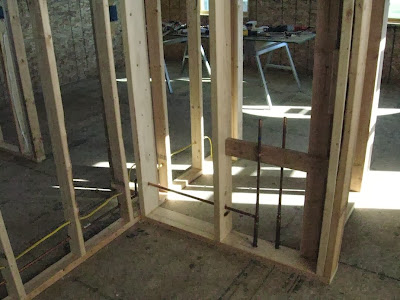Then I flipped it, cut it into 3 sections (the door itself and the fills to the sides), and then framed the interior to be hollow and insulated with R-5 Styrofoam.
The porthole was to let some light into the entry hall...and it just looks cool. The process took some months, as Eric would find time for this when he could. Note the electrical switch boxes for the outside porch light and the entry hall light to the left of the side of the door that will be latched.
Also during the spring we started the window seat next to the master bath bathtub. The idea was to add some architectural relief to the front of the house, while adding a nice little feature next to the bathtub. One could fill the bath, turn on the whirlpool, open the windows and light some candles on the window seat. Very relaxing!
But actually framing the thing some 15' off the ground? That didn't seem like very much fun. So here's how we did it. Here, Eric frames the basic shape.
We're looking at it with it's exterior face down on sawhorses. The little angled blocks are for a short pitched roof, and the long "tongue" of framing facing up to the top of the photo is the upper anchor. The idea was to build this so that it could be hoisted into place, "dropped" sideways onto the opening in the large square hole master bathroom, and come to rest against the house with the tongue sliding against the header over that opening. Then it could be nailed and bracketed to the framing members around the opening.
Here are our neighbor Albert with Julie on the ground. Our friend Jeb is in the opening. he has a nail gun ready. This shot is taken from the front seat of the Jeep by Eric. The ropes go from the bumper hooks on the jeep, up to 2 blocks screwed into the roof framing, and then down to heavy eyelets bolted through the frame of the window seat.
Note the roll of Tyvek taped fast at the top of the unit. This is so we can just go up afterward and unroll it, and staple/tape the vapor barrier fast to the rest of the Tyvek already in place for a good weather seal.
Here's Julie shouting directions as we try to keep it level on the hoist .
Note that Eric's viewpoint is to the right now, having steered to get extra slack out of the one side.
And the finished product, awaiting the windows, which by then were on order from Pella.
In our next episode...ELECTRICITY!
















